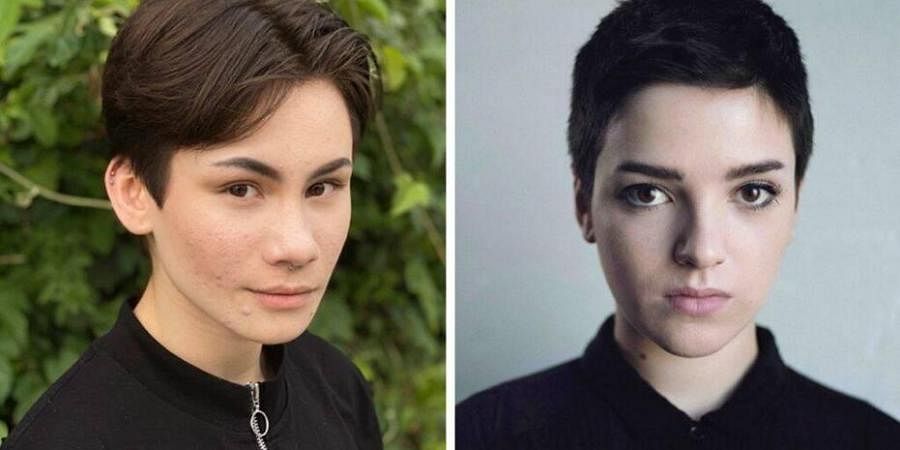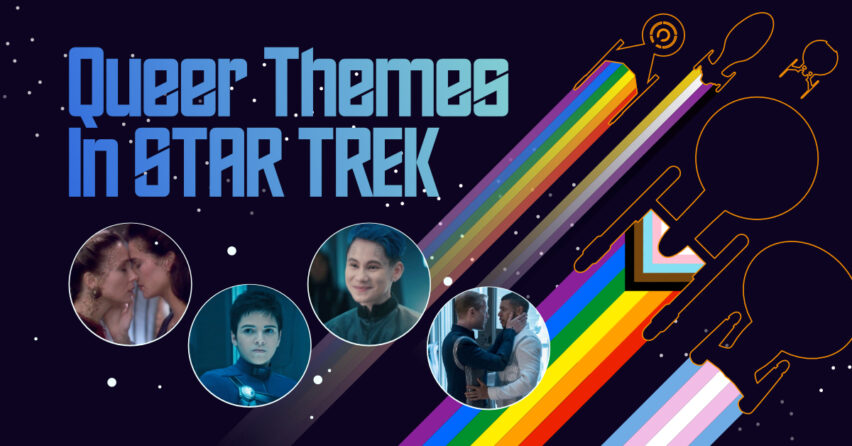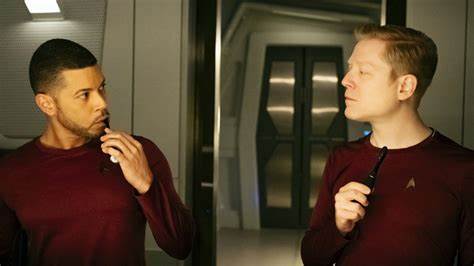Queer Themes in Star Trek
By Siobhan Donegan
The ground-breaking popular TV series Star Trek Discovery now in its third season has made Trek history in the Sci-fi franchise by introducing for the first time a Non-binary and a Transgender character. These are Non-binary actor Blu del Barrio, who plays Adira and Trans actor Ian Alexander as Gray. This latest and up to date incarnation of what is in all probability the most successful Sci-fi franchise has already broken new ground in its opening season with the introduction to the series of the first ever openly gay couple, namely Lt. Commander Paul Stamets played by actor Anthony Rapp and Dr Hugh Culber-Wilson Cruz, both of whom are members of the LGBT community in real life.
Michelle Paradise, Co-Showrunner of Discovery, explained that ‘Star Trek has always made a mission of giving visibility to unrepresented communities’, further explaining that this is because of the faith in a ‘future without division on the basis of race, gender ,gender-identity, or sexual orientation’. Hence the moral philosophy or agenda of the show encompasses the ‘gender revolution’ of the current identity politics.
If we go back to the beginning to the original Star Trek series-we find that by pushing the boundaries of representation on television, as regards gender and ethnicity, this show was attempting to ‘boldly go where no one has gone before’. Furthermore, some episodes were used to explore political and social issues of the time using metaphor reflecting a decade which was a revolutionary one of change.
In fact the moral agenda of Star Trek has always been to celebrate ‘humanity’s potential for tolerance and understanding’ which would seem to be represented not only in its revolutionary portrayal of people from different ethnic backgrounds, but also the very foundations on which the ‘Federation’ was built. Despite this and despite the fact that Star Trek Creator Gene Roddenberry admitted that his thinking/attitude towards the LGBT community had to evolve, telling The Humanist in 1991, ‘My attitude towards homosexuality has changed-I came to the conclusion that I was wrong’. Unfortunately, it still took a whole 28 years after Roddenberry had passed away for the first gay character to appear in Star Trek.
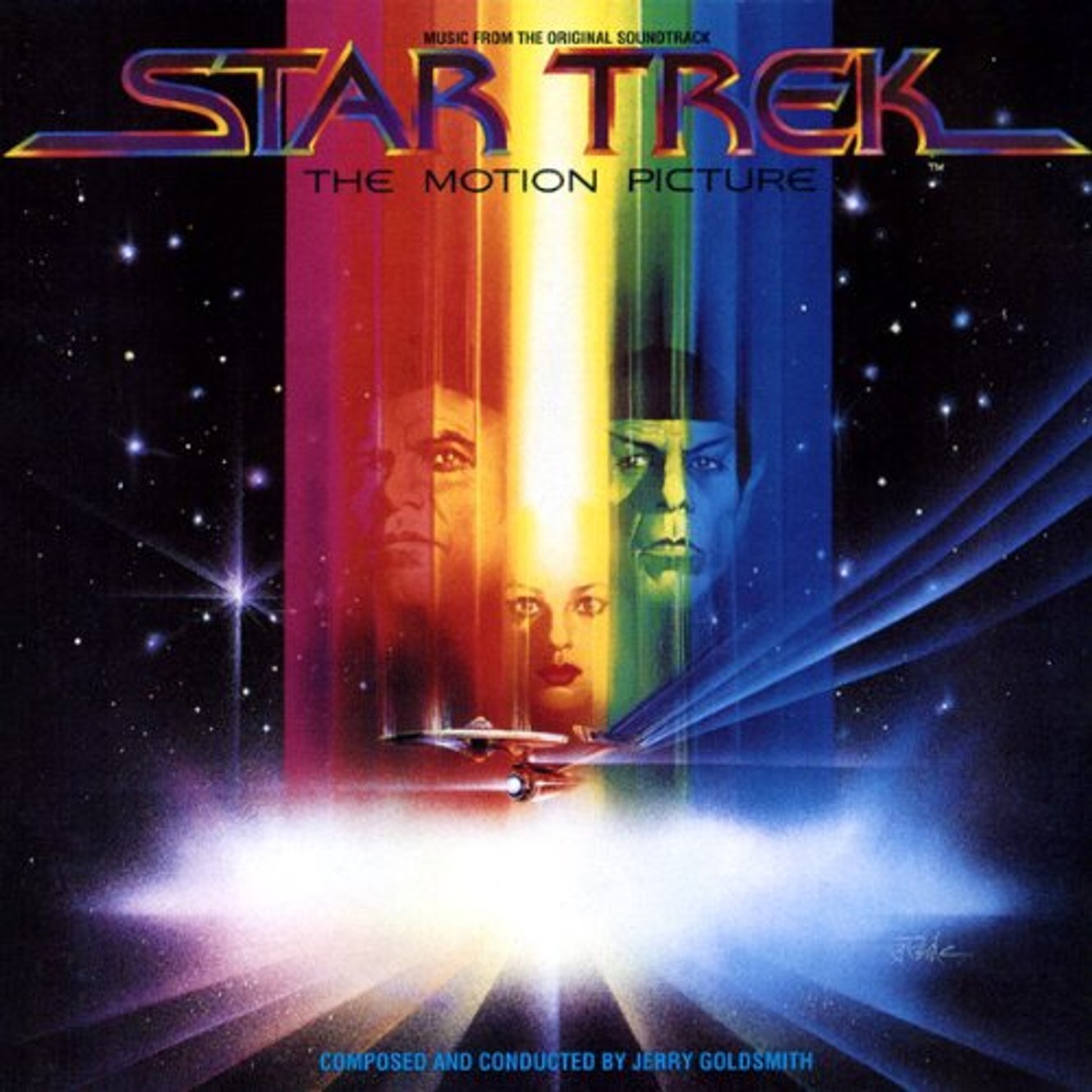 Although the original Star Trek has been acknowledged as having stories that dealt with gender politics it never had any explicit reference to queer representation. However, through the perception of the fan community the relationship between Captain Kirk and first Officer Spock was seen to have a queer subtext and as such these two officers were portrayed as a same sex couple in a number of fanzines circulated in the 1970s. Furthermore in this context although comics, novels, ‘fan work’ showed good LGBT representation amongst its fictional Starfleet characters-this was all considered to be ‘non-canonical’. Within the official Star Trek franchise, in its various incarnations, any notion of ‘queer identity’ was cast into the limbo of ambiguous symbolism and metaphor.
Although the original Star Trek has been acknowledged as having stories that dealt with gender politics it never had any explicit reference to queer representation. However, through the perception of the fan community the relationship between Captain Kirk and first Officer Spock was seen to have a queer subtext and as such these two officers were portrayed as a same sex couple in a number of fanzines circulated in the 1970s. Furthermore in this context although comics, novels, ‘fan work’ showed good LGBT representation amongst its fictional Starfleet characters-this was all considered to be ‘non-canonical’. Within the official Star Trek franchise, in its various incarnations, any notion of ‘queer identity’ was cast into the limbo of ambiguous symbolism and metaphor.
In 1986 at a 20th anniversary convention, a founding member of the Boston LGBT science fiction group The Gaylaxian Network and fan of Star Trek, pointed out that the series had taken the ground breaking step of bringing Black and Asian characters to television, and furthermore asked Gene Roddenberry himself-whether the series Star Trek-The Next Generation would introduce gay characters to the show. At the time Roddenberry agreed stating’ ‘Sooner or later, we’ll have to address the issue. We should probably have a gay character’.
The Gaylaxians by 1990 had begun to put pressure on the show’s producers with a letter writing petition. Roddenberry didn’t, it would seem, need convincing intending to make good on his promise. He wrote, ‘In the fifth season of Star Trek-The Next Generation viewers will see more of shipboard life which will include gay crew members in day-to-day circumstances.’ However, this LGBT friendly Starfleet environment never materialized due to the fact that in October 1991 Roddenberry unfortunately died.
 However, there is an episode of Star Trek: The Next Generation that is definitely worth mentioning; this is episode 17-season 7-titled ‘The Outcast’-which can be and has been interpreted as allegorical of queer issues outside of the heteronormative binary. In this episode an alien species known as the J’naai-in which gender binary doesn’t exist is encountered by the crew of the Enterprise. However, as the story unfolds Commander Riker meets and works with a J’naai named Soren who reveals to him that she ‘feels’ as though she is female resulting in the two becoming romantically involved. Obviously in retrospect it is easy to see how such a fascinating episode would have ‘spoken’ to fans who were transgender and other members of the LGBT community.
However, there is an episode of Star Trek: The Next Generation that is definitely worth mentioning; this is episode 17-season 7-titled ‘The Outcast’-which can be and has been interpreted as allegorical of queer issues outside of the heteronormative binary. In this episode an alien species known as the J’naai-in which gender binary doesn’t exist is encountered by the crew of the Enterprise. However, as the story unfolds Commander Riker meets and works with a J’naai named Soren who reveals to him that she ‘feels’ as though she is female resulting in the two becoming romantically involved. Obviously in retrospect it is easy to see how such a fascinating episode would have ‘spoken’ to fans who were transgender and other members of the LGBT community.
Furthermore, in season 3 of Star Trek: The Next Generation an episode called ‘The Offspring’ perhaps marked the beginning of an exploration and a willingness on the part of the writers of gender identity and ‘shifting gender’. In this episode, Data apparently wanting to embrace parenthood, creates an ‘artificially intelligent child’ who is given the option of not only choosing their race but also their gender identity-presentation, the child eventually choosing to present as Female.
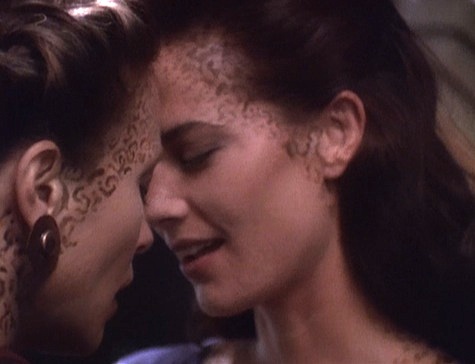 The next milestone in the Star Trek franchise was Star Trek: Deep Space Nine. One of the main characters of the series was Lieutenant Commander Jadzia Dax who in all probability was the most symbolically queer character of the Sci-fi series up until the advent of S. T. Discovery. Dax is of the alien species Trills who coexist in a mutually beneficial relationship with slug like symbionts who unlike their Trill hosts have extremely long life spans. Iin fact the symbionts can live up to 700 years, whereas the Trills have a similar lifespan to the average human. Furthermore, considering the fact that the symbionts can switch from male to female bodies, their Trill hosts can thus have access not only to male and female memories, but also feelings including sexual attraction. This Science fiction premise was instrumental for the writers of Deep Space Nine being able to ‘Push the boundaries of sexuality’.
The next milestone in the Star Trek franchise was Star Trek: Deep Space Nine. One of the main characters of the series was Lieutenant Commander Jadzia Dax who in all probability was the most symbolically queer character of the Sci-fi series up until the advent of S. T. Discovery. Dax is of the alien species Trills who coexist in a mutually beneficial relationship with slug like symbionts who unlike their Trill hosts have extremely long life spans. Iin fact the symbionts can live up to 700 years, whereas the Trills have a similar lifespan to the average human. Furthermore, considering the fact that the symbionts can switch from male to female bodies, their Trill hosts can thus have access not only to male and female memories, but also feelings including sexual attraction. This Science fiction premise was instrumental for the writers of Deep Space Nine being able to ‘Push the boundaries of sexuality’.
To add to the metaphorical/symbolic complexity there is a Trill law against ‘re-association’. This was explored dramatically in the episode ‘re-joined’ 1995 in which Jadzia encounters Lenara Khan, who happened to be the wife of one of Dax’s previous male hosts. Ultimately Jadzia and Lenaraare unable to resist their mutual attraction-leading to Star Trek’s first ever historic Gay Kiss. At the time this was one of the producer’s ways of ‘challenging taboos’.
Returning to the brilliant Star Trek Discovery Season 3, Wilson Cruz, who is a gay actor who plays Dr Hugh Culber and partner to Anthony Rapp, who plays ‘mycelial network engineer’ Lt. Commander Paul Stamets stated, ‘I’m proud to say that we are bringing you the queerest Trek in history’. As mentioned above this season introduces Non-binary actor Blu del Barrio as Adira, and it is through them that we meet their transgender alien Trill boyfriend Gray played by transgender actor Ian Alexander who is the first openly transgender Asian American to appear in an American TV series.
